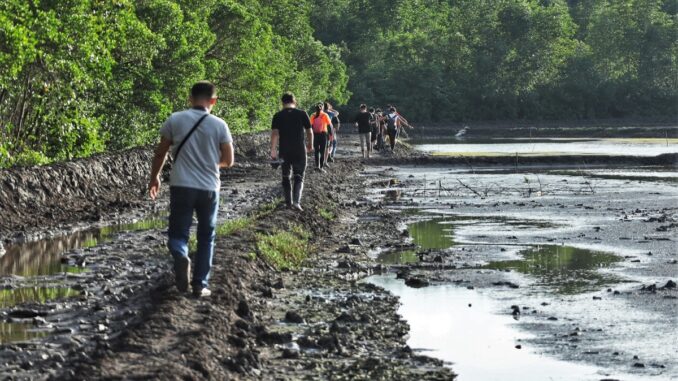
Thieng Lieng hamlet in Thanh An island commune, Can Gio has a long-time salt industry, peaceful scenery, and friendly people.

In mid-October, Tran Dang Dang Khoa had a trip to Thieng Lieng hamlet in Can Gio island district, more than 70 km from the center of Ho Chi Minh City. This is his first trip after the city eases social distancing, so he can’t help but be excited: “In Can Gio before, I have been to Can Thanh town, Thanh An island but have not been to Thieng Lieng hamlet. ever, this land is very rustic, still retains the peaceful features of the river village. Breathe and immerse in the beautiful green nature, enjoy the scenery very comfortably.”

In the past, if you want to go to Thieng Lieng, you have to go to Can Thanh, take a boat through Thanh An commune and then continue through Thieng Lieng hamlet, you have to take 2 boats to get there and this is also the only means for people to get there. moving between the island and the mainland at that time. But today, the road to Thieng Lieng has been shortened, visitors can take a shortcut from the boat station of the Can Gio Protection Forest Management Board by canoe straight to Thieng Lieng, shortening the road by 20 km and 10 km. Waterway.

The salt field in Thieng Lieng is seen from above, this place has not yet entered the salt season. The people of Thieng Lieng make salt from December to May every year. This is one of three hamlets in the island commune that make salt, with nearly 400 hectares of fields, producing more than 20,000 tons of salt each year.

Salt-making households in Thieng Lieng all have a salt storage area after harvesting, the quality of salt is better than that of many other places, but the resale price is lower because of transportation costs. To transport salt for consumption, there must be boats of traders from Tien Giang, Tay Ninh, Binh Phuoc… to buy.

Tourists ride bicycles on the beautiful concrete road to enjoy the wind, the car passes through the thatched roofs and the vast salt fields of the people of Thieng Lieng.

The wild, rustic scenery on both sides of the road is reminiscent of countryside in the Southwest region with thatched roofs and stretches of nipa groves.

The tray of rice treats guests of Thieng Lieng people with porridge, salad from saltwater duck, seafood, fish, shrimp, and squid caught in the island hamlet. Dang Khoa said his tour group consisted of more than 10 people, more than the previous visits to Thieng Lieng, so people set up tables to eat at the cultural house, and local officials also supported the cooking place. “Thien Lieng has not developed many food services but everyone is very sincere and close, giving me a feeling of closeness like a family member who has been visiting his hometown for a long time,” he shared.

After lunch, the group rested and started to depart for Giong Chua mountain, a rare mountain in the middle of the mangrove forest. The way to the mountain depends on the water in Thieng Lieng, if the water is too dry the canoes and boats will not reach the place and are forced to turn around.

Sunset at Giong Chua mountain is called a mountain, but this place is just a rocky hill about more than 10 meters high and is considered an interesting place to check-in in the middle of Thieng Lieng mangrove forest. Khoa’s trip lasted 12 hours, departed in the morning, and at 18:30, the group was present in the city center.

“When I come to Thieng Lieng, I feel like I can immerse myself in people’s lives, children have fun, adults visit salt fields, go fishing, live on the river… I can feel it all and see it. very peaceful, not too busy, very comfortable for the 12-hour journey”, Tran Dang Dang Khoa stated. Follow vnexpress
Photo: Tran Dang Dang Khoa
